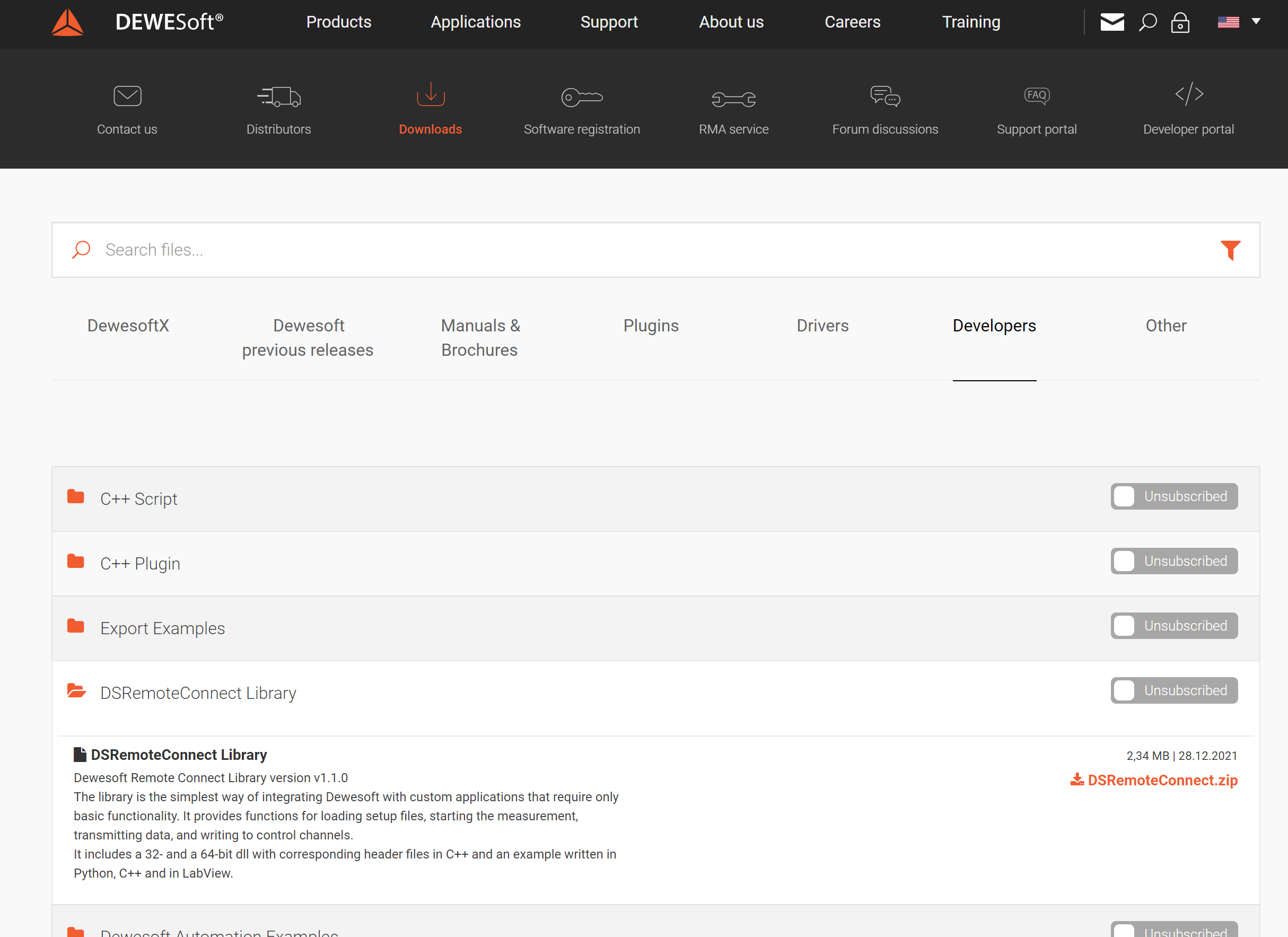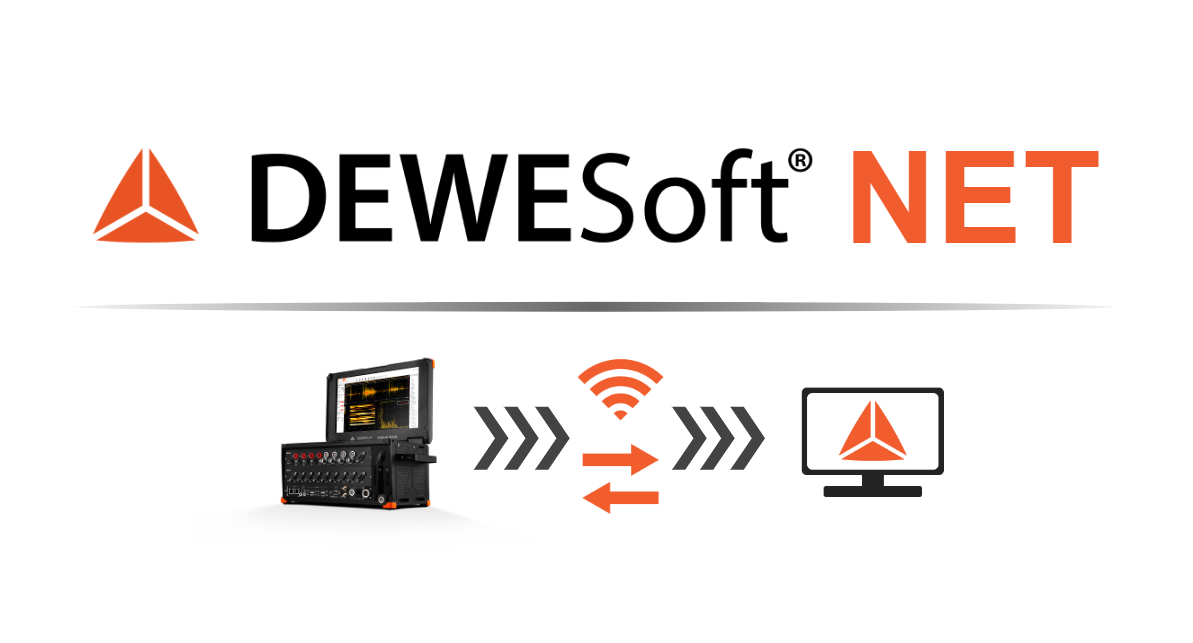Now let's take a look at an example
from ctypes import *
import ctypes from ctypes.wintypes import *
import time
import numpy as np
def doErrCheck(err_code, descr):
if err_code < 0:
print(str(descr) + " errCode: " + str(err_code))
return err_code
hllDll = WinDLL ("C:\\DXEProjects\\Tools\\DSRemoteConnect\\DSRemoteConnect\\Debug\\DSRemoteConnect64.dll")
dsconInstance = HANDLE()
doErrCheck(hllDll.dsconCreateInstance(pointer(dsconInstance), 1), "dsconCreateInstance")
charArray = create_string_buffer("10.2.120.255:8999:8001".encode())
doErrCheck(hllDll.dsconConnect(dsconInstance, charArray), "dsconConnect")
numChannels = c_size_t()
doErrCheck(hllDll.dsconGetChannelCount(dsconInstance, byref(numChannels)), "dsconGetChannelCount")
print(numChannels.value)
# Second way of enumerating Channels
labelsPtr = pointer((POINTER(ctypes.c_char_p) * numChannels.value)()) localValue = c_size_t(numChannels.value)
hllDll.dsconEnumerateChannels(dsconInstance, labelsPtr, byref(localValue))
name = (c_char * 50)()
ch_name = ctypes.cast(name, c_char_p)
unit = (c_char * 50)()
ch_unit = ctypes.cast(name, c_char_p)
ch_instances = []
for i in range(0, numChannels.value):
name = (c_char * len(labelsPtr[0][0][i]))()
ch_index = ctypes.cast(name, c_char_p)
ch_index.value = labelsPtr[0][0][i]
ch_instance = HANDLE()
hllDll.dsconCreateChannelInstance(dsconInstance, ch_index, pointer(ch_instance))
ch_instances.append(ch_instance)
hllDll.dsconChannelGetName(ch_instances[i], ch_name, 50)
print(ch_name.value)
hllDll.dsconGetChUnit(ch_instances[i], ch_unit, 50)
print(ch_unit.value)
doErrCheck(hllDll.dsconChannelSetTransferred(ch_instances[len(ch_instances) - 1], False), 'dsconChannelSetTransferred')
doErrCheck(hllDll.dsconStartMeasurement(dsconInstance), "dsconStartMeasurement")
data2 = ctypes.cast((c_double * 100000)(), POINTER(c_double))
time_stamps2 = ctypes.cast((c_double * 100000)(), POINTER(c_double))
count = 0
while True:
try:
countData2 = c_size_t(100000)
for i in range(len(ch_instances)):
doErrCheck(hllDll.dsconChannelReadScalarData_2(ch_instances[i], data2, time_stamps2, byref(countData2)), "dsconChannelReadScalarData_2"
doErrCheck(hllDll.dsconControlChannelWriteData(ch_instances[1], c_double(0.69 + count)), "dsconControlChannelWriteValue1")
doErrCheck(hllDll.dsconControlChannelWriteData(ch_instances[2], c_double(0.70 + count)), "dsconControlChannelWriteValue2")
doErrCheck(hllDll.dsconControlChannelWriteData(ch_instances[3], c_double(0.71 + count)), "dsconControlChannelWriteValue3")
count += 1
except:
print("While interrupted")
break
print("Finally")
doErrCheck(hllDll.dsconStopMeasurement(dsconInstance), "dsconStopMeasurement")
doErrCheck(hllDll.dsconDisconnect(dsconInstance), "") # this will close Dewesoft.exe and clear the DCOM
for i in range(0, numChannels.value - 1):
doErrCheck(hllDll.dsconFreeChannelInstance(ch_instances[i]), "dsconFreeChannelInstance") # this will free chnl instances of dll
doErrCheck(hllDll.dsconDestroyInstance(dsconInstance), "dsconDestroyInstance") # this will free dll instance
The example is written in python. This example uses Dewesoft Net as protocol and firstly outputs the channels that are present in the setup and outputs their name and unit. After listing information, we go into measure mode and read the data. After the data is read, we write some values to control the channel. Now let’s look at the code by sections.
In the following section, we are listing the channels and outputting the channel name and unit.
numChannels = c_size_t()
doErrCheck(hllDll.dsconGetChannelCount(dsconInstance, byref(numChannels)), "dsconGetChannelCount")
print(numChannels.value)
# Second way of enumerating Channel
labelsPtr = pointer((POINTER(ctypes.c_char_p) * numChannels.value)())
localValue = c_size_t(numChannels.value)
hllDll.dsconEnumerateChannels(dsconInstance, labelsPtr, byref(localValue))
name = (c_char * 50)()
ch_name = ctypes.cast(name, c_char_p)
unit = (c_char * 50)()
ch_unit = ctypes.cast(name, c_char_p)
ch_instances = []
for i in range(0, numChannels.value):
name = (c_char * len(labelsPtr[0][0][i]))()
ch_index = ctypes.cast(name, c_char_p)
ch_index.value = labelsPtr[0][0][i]
ch_instance = HANDLE()
hllDll.dsconCreateChannelInstance(dsconInstance, ch_index, pointer(ch_instance))
ch_instances.append(ch_instance)
hllDll.dsconChannelGetName(ch_instances[i], ch_name, 50)
print(ch_name.value)
hllDll.dsconGetChUnit(ch_instances[i], ch_unit, 50)
print(ch_unit.value)
print(ch_unit.value)
Before we can loop over all the channels we need to find out how many channels are there. To get this information we need to call the function
int dsconGetChannelCount(DSXInstanceHandle handle, size_t* count);
As the first parameter, we pass the instance that we described in the section. As the second parameter, we by reference pass the value. After calling this function, the number of channels that are present in the DewesoftX will be stored in this variable. Before we can access the properties we need to get the unique ID that presents a channel. To get the unique ID’s we call the function.
int dsconEnumerateChannels(DSXInstanceHandle handle, ChannelIdList* channelIdList, size_t* count);
This will return values by reference. The second parameter will return an array of strings, each element representing unique ID for each DewesoftX channel. The last parameter returns how many channels are there present in the array. Unique IDs are used to create DewesoftX channel instances. To create a channel instance we call function.
int dsconCreateChannelInstance(DSXInstanceHandle handle, ChannelID id, ChannelInstanceHandle* chInstance);
The channel instance is returned as the third parameter by reference. With the acquired channel instance we can get info about channel name and channel unit. To get the channel name we call the function
int dsconChannelGetName(ChannelInstanceHandle channel, char* name, size_t len);
and to get the channel unit we call the function
int dsconGetChUnit(ChannelInstanceHandle handle, char* resultUnit, size_t len);
After each call, we print it to standard output.
In the next section, we will take a look at how to read and write the data to channels. Let's take a look at the section.
doErrCheck(hllDll.dsconStartMeasurement(dsconInstance), "dsconStartMeasurement")
data2 = ctypes.cast((c_double * 100000)(), POINTER(c_double))
time_stamps2 = ctypes.cast((c_double * 100000)(), POINTER(c_double))
count = 0
while True:
try:
countData2 = c_size_t(100000)
for i in range(len(ch_instances))):
doErrCheck(hllDll.dsconChannelReadScalarData_2(ch_instances[i], data2, time_stamps2, byref(countData2)), "dsconChannelReadScalarData_2")
doErrCheck(hllDll.dsconControlChannelWriteData(ch_instances[1], c_double(0.69 + count)), "dsconControlChannelWriteValue1")
doErrCheck(hllDll.dsconControlChannelWriteData(ch_instances[2], c_double(0.70 + count)), "dsconControlChannelWriteValue2")
doErrCheck(hllDll.dsconControlChannelWriteData(ch_instances[3], c_double(0.71 + count)), "dsconControlChannelWriteValue3")
count += 1
except:
print("While interrupted")
break
print("Finally")
doErrCheck(hllDll.dsconStopMeasurement(dsconInstance), "dsconStopMeasurement")
doErrCheck(hllDll.dsconDisconnect(dsconInstance), "") # this will close Dewesoft.exe and clear the DC
for i in range(0, numChannels.value - 1)
doErrCheck(hllDll.dsconFreeChannelInstance(ch_instances[i]), "dsconFreeChannelInstance") # this will free chnl instances of dewesoft
doErrCheck(hllDll.dsconDestroyInstance(dsconInstance), "dsconDestroyInstance") # this will free dll instance
Before we can start reading or writing the data we first need to go to the measure. To switch to measure mode we need to call the function
int dsconStartMeasurement(DSXInstanceHandle handle);
After this call, we can read and write the data to channels. This library supports reading the data from any channel but only supports writing to control channels. To know if the channel is the control you need to call the function.
int dsconIsChannelControl(ChannelInstanceHandle handle, bool* result);
Before we can read the data we need to allocate a local buffer. The samples from the channels will be added to this buffer. If you take a look at python we see in the following code
data2 = ctypes.cast((c_double * 100000)(), POINTER(c_double))
time_stamps2 = ctypes.cast((c_double * 100000)(), POINTER(c_double)
That we are preallocating local buffer for data and timestamps. The size is 100000 double values. The size of the local buffer depends on how many values from DewesoftX values will be copied. In case the preallocated buffer is too small, samples in DewesofX will be lost, because they will be overwritten. The following function:
int dsconChannelReadScalarData_2(ChannelInstanceHandle handle, double* data, double* timestamps, size_t * count);
accepts several parameters. The first one accepts a channel instance which represents the channel from which we will read the data. The second and third parameters accept preallocated buffer as the fourth parameter the function accepts the size of the buffer. In case the number of samples available is lower than the size of the buffer it will change is accordingly to the number of added samples.
As pointed before we have also added a function to write to control channels. Function for writing values to control channels looks like this:
int dsconControlChannelWriteData(ChannelInstanceHandle handle, double data);
Same as in dsconChannelReadScalarData the first parameter represents the channel instance that is connected to the DewesoftX channel. The second parameter presents the value that we want to write to the control channel.
After we are done with the measurement we call the function:
int dsconStopMeasurement(DSXInstanceHandle handle);
After we are done with measurement and want to stop the program, we need to disconnect from the DewesoftX. To do this we call the function:
int dsconDisconnect(DSXInstanceHandle handle);
After we are disconnected, we also want the software to be closed correctly. The software will be closed correctly if we free all the instances we made during our software. To do this we have these functions:
int dsconFreeEnumerateChannels(DSXInstanceHandle handle, ChannelIdList* channelIdList)
int dsconFreeChannelInstance(ChannelInstanceHandle chInstance)
int dsconDestroyInstance(DSXInstanceHandle handle);
With dsconFreeEnumerateChannels we clean the array of strings that we made during the call of function dsconEnumerateChannels. With the function dsconFreeChannelInstance, you clean the channel instances that were made with the function dsconCreateChannelInstance. After all other instances are freed, we call the last function dsconDestroyInstance.




